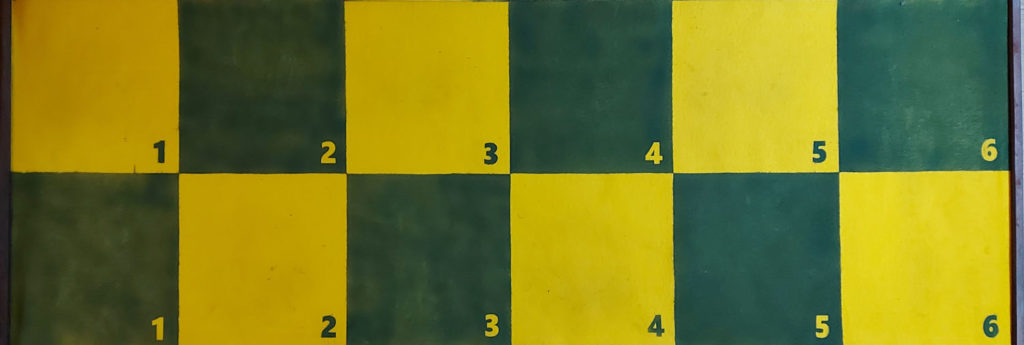It’s a bit embarrassing when you get showered with inaccurate plaudits.
The Kildwick MiniRingers have a popular party-piece which is ringing Plain Bob (usually doubles) “on the mat”. That mat is like a 2-row slice of a chessboard. White (or yellow for us) is handstroke and black (green) is back. You step anticlockwise around the mat to achieve plain hunting – and then develop through Penultimus to Plain Bob or Grandsire – or anything else that takes your fancy.
The story, locally, is that this is all my own invention but, of course, “walking through a method” is nothing new at all. I’ve just made a mat to do it on. It does, though, have some huge advantages for a group like the MiniRingers.
 The important thing is that it turns the teaching of methods on its head. That’s necessary when you have half a dozen youngsters and no existing band of “experts” to ring with them. Even if there were to be a band, there’d be little for the other five to do as they stood and watched.
The important thing is that it turns the teaching of methods on its head. That’s necessary when you have half a dozen youngsters and no existing band of “experts” to ring with them. Even if there were to be a band, there’d be little for the other five to do as they stood and watched.
Lesson 1, as always, is, as it were, “bell handling”. We normally use handchimes rather than our beautiful (ART-Award-funded) restored handbells which only come out on high days and holydays. Getting them to strike is a very small issue – we’re quite used to these by now but the difficult part is the exacting “Ring-Step… Ring-Step…” routine. Don’t step before you ring! Don’t forget to step after you ring! Don’t forget to ring!
We practice this, stepping around the mat in Plain Hunting. Even that is very taxing for some. The cover bell is a very useful option!
In Lesson 2 we move on to Penultimus. Here, as in so many methods, the treble is key and so that’s where the most reliable ringer goes. Hunting up to the penultimate place (4th place in doubles), the treble prevents one bell – sometimes physically – from leaving the back and so a firm and clear treble helps it all to keep right. Everyone else just plain hunts and the only trouble I have is that the tune is “wrong” to those who have listened to Plain Bob all their lives!
We then move on to Plain Bob in Lesson 3. Instead of one bell doing something different when the treble is at the back, they all do something when it leads. Step (a) is for the treble to say so. It seems to work best, not at any normal point, but actually when it is moving from the hand-to backstroke of the lead. A simple, quiet “Leading”.
It took me far too long to realise that talk about “3-4 dodges” or “four blows behind”; the “Circle of Work” or “Course Bells” is irrelevant at this stage. The instruction is simple. “When the treble is leading, step back one then continue”. That immediately shows a problem, so then we work out what the bell in seconds place has to do.
And that’s it, bar the shouting. And, yes, there can be some of that too. As they ring it, they notice patterns. I don’t teach them; they notice it themselves. They very quickly learn that, if the treble is following them down the back row of the mat, it is their turn to make seconds. If the position is reversed, then they will be dodging (“step back”; we don’t talk about dodging) on the 3 and 4 mats. Passing the treble is a bit more difficult; the treble is always on the opposite “side” of the mat and when hunting up, it is behind them as they face the front and the audience.
And that’s one of the great things about this. It is a good spectator sport. In their bright red polo shirts and a contrasting yellow treble they weave a fascinating pattern as they dance around the mat. The sound is familiar to most ears attuned to the English soundscape and so it is accessible – and remarkably popular in a way that some rather hesitant tune ringing on those same bells or chimes may not be.
I could write (and maybe I will!) about the use of these things (tunes and changes within events such as the Music Festival where our children have recently performed. But Festivals like this make a wonderful shop window!
… and moving on. Ringing on the mat is valuable – and every year, we seem to push the boundaries a little further. We start to think about “what next?” Touches are an obvious extension – though a plain course of doubles is a good length. We ring at a peal speed of about 7¼ hours. Any faster and it just doesn’t work. We do ring for longer; we’ve successfully completed Penultimus Royal in about 14 minutes. So we’ll investigate bobs, I expect. A 120 takes about 10 minutes. But there are always other thoughts. Stedman works to a fairly predictable pattern – and we were ringing Duffield online the other day. With its “leads” of six changes and a dead simple place notation, I think that could be fun to investigate…


